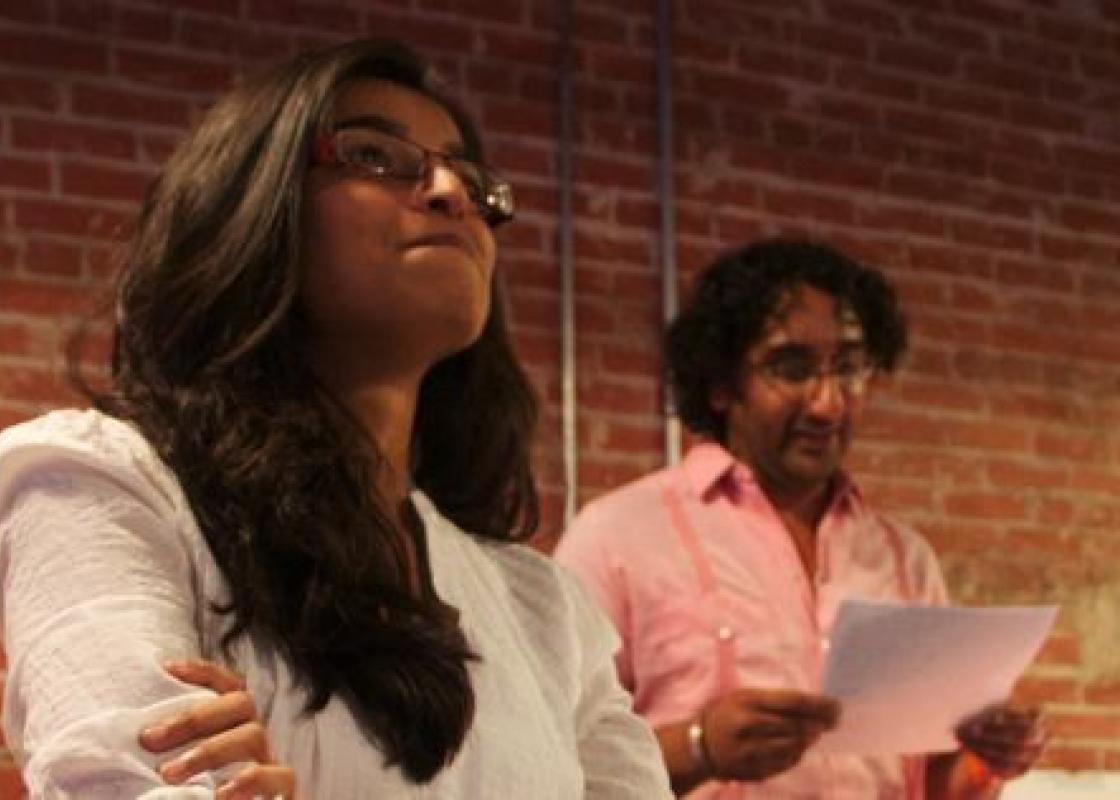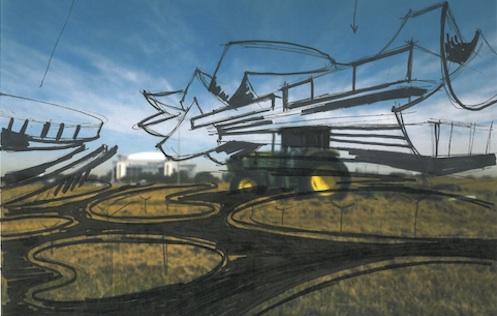

Tara Mather, Masa Lemu, Allyn West, and Marcel LaFlamme imagine Houston in 2042.
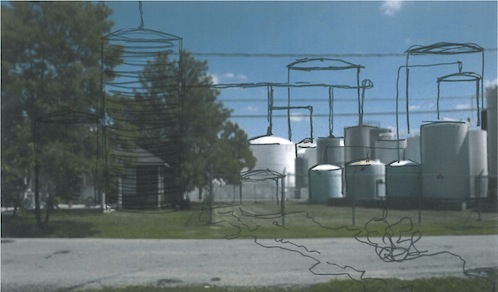
Tara Mather draws proliferating storage tanks on a photo by Paul Hester in Cite 79.

Harbeer Sandhu reads as Kareeshma Ali looks on.
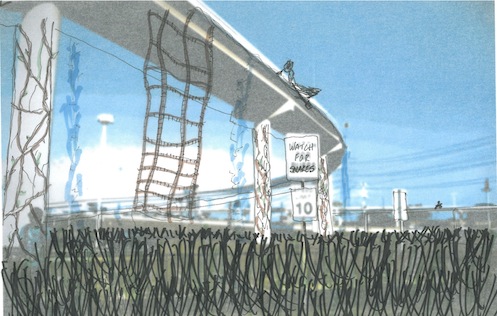
Ali draws over a photo of the Hillcroft Transit Center by Rose Kuo.
A mega sports complex mixing Zaha Hadid and Gehry elements drawn by Masa Lemu over a photograph of the Astroworld site by Sharon Steinmann in Cite 81
Last Thursday evening, Cite celebrated the release of its new issue at Asakura Robinson, an urban planning and landscape architecture firm. Their offices on the second floor of 1902 Washington Avenue provided ample room. In the midst of the crowd, five writers and five drawers---most around thirty years old---played a game in which they were challenged to imagine what specific Houston sites could become in 30 years. After about forty minutes, the rough drawings were shown while the writers read out text. The visions were wildly different, even contradictory, but many of them matched dystopia with mirth. The collapse of the world as we know it will be fun, or at least funny in its absurdity. Check out the drawings and text below, followed by party pics.
Honey. The miracle food of the 2040s is honey, affording sure protection from the solar flares. Elevators groaning with honey dot the horizon, tall and sleek, short and squat. A viscous river of honey flows toward the foreground and a waiting supertanker (not pictured). Text by Marcel LaFlamme.
It's 2050, and though Earth still has vast pockets of untapped oil, it's simply not practical to pump it out of the ground anymore. The costs vastly outweigh the benefits---extraction requires more energy than the oil will deliver.
Houston, once defined by its freeways---those grand achievements of engineering, those towering cathedrals of steel and concrete---no longer has any use for them. The city has grown denser, connected by light rail and bicycle paths. The surburbs and exurbs have become more autonomous---less people commute significant distances, and for them there is a new system of commuter rail. And those stretches of grass along the freeway easements? Those now grow food and biofuels (for rail).
But the freeway overpasses---the most popular "public space" in Houston 2012, the only points providing the vantage point of elevation on this coastal plain---they've been converted to water parks!
Kayaking, swimming, water slides all provide a welcome break from the summer heat. Need a break to cool off on your bike ride home? Take a slide down the Westpark-59 interchange! Text by Harbeer Sandhu.
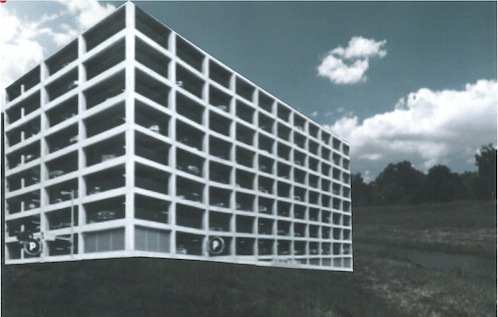
Garage on the bayou collage by Nestor Topchy using photos by Jack Thompson.
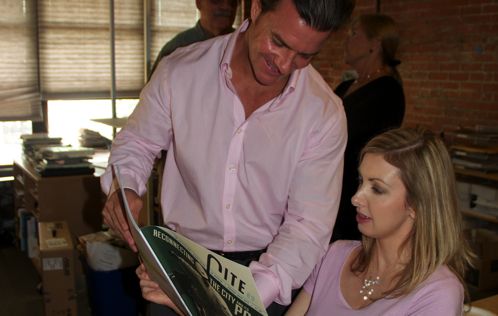
Benjamin Urban and Jennifer Batchelor

Lou Vest
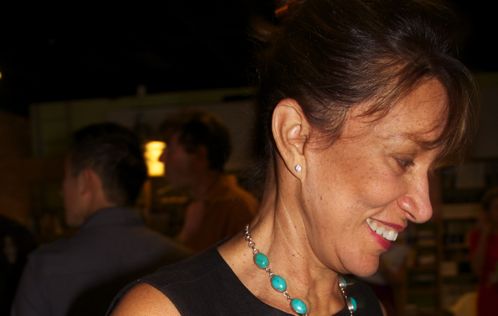
Emilce Vest

Laura Bellows and Rich Levy
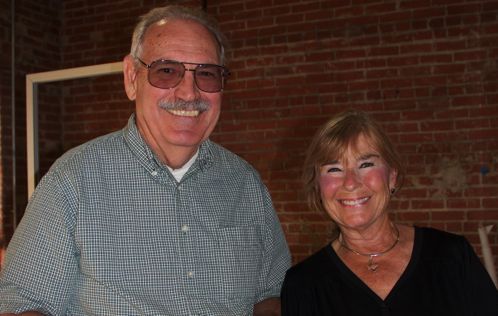
Louis Albach and Linda Gorski
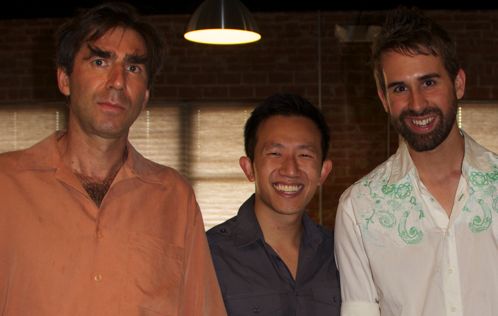
Nestor Topchy, Sam Lam, and Marcel LaFlamme
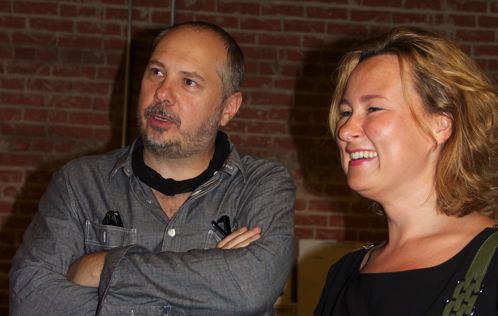
Christopher Sperandio and Patricia Bieberstein
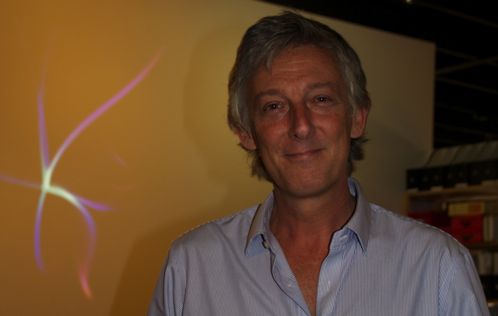
Fernando Brave

Mary Beth Woiccak and Katie Plocheck

Raj Mankad

Joe and Jessica Ross

Allyn West and Sara Cooper
Inspired by the desperate ingenuity of the Chinese civic engineers, Houston’s architecture design community implemented their latest last-gasp attempt to detail with vehicle overcrowding. Thomas Bigface, owner of the River Oaks Automobile Co-op, an offshoot of the failed Heights Drive-and-Share, was a vocal proponent of this new venture. Over the course of six different city council meetings, Bigface filibustered attempts by the Save the Bayous Campaign to keep the last remaining green-spaces in the city undeveloped.
Bigface’s push convinced the city to allow private contractors to build overflow parking garages on the bayous banks. Spaces were sold to the highest bidder, keeping with the city’s longstanding policy of reserving its HOV lanes for those who could afford the tolls.
“Where am I supposed to keep my Land Rovers?” says Bigface.
Calls to the Bayous or Death office were not returned.
In related news, gar have been found gnawing on the tires of German cars in at least four of the new garages. Text by Allyn West.


